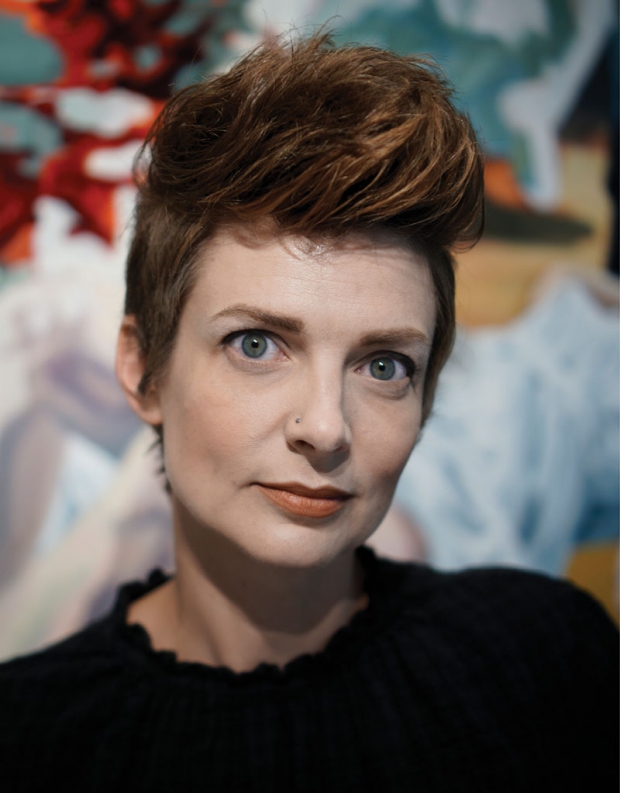Yvette Cummings’ exhibit Everything Will Be OK at the Burroughs and Chapin Art Museum

After months of virtual operation and shuttered exhibit halls, the Franklin G. Burroughs-Simeon B. Chapin Art Museum of Myrtle Beach is ready to receive visitors once again, showcasing the work of local artist Yvette L. Cummings (Arendt).
Cummings’ exhibit Everything Will Be OK, featuring paintings, sculptures, and installation pieces that explore themes of childhood, feminine beauty, and the societal gaze, will be on display through September 13, 2020.
An award-winning artist and assistant professor of visual arts in painting and drawing at Coastal Carolina University, Cummings has displayed her works in solo and group exhibitions throughout the South and the Midwest over the past two decades. She was one of 65 artists selected for the Mint Museum’s Coined in the South Exhibition 2019, in Charlotte, N.C.; was featured in the 701 Center for Contemporary Art (CCA) South Carolina Biennial 2019 and 2015 in Columbia, S.C.; and won the 2016 701 CCA Prize for Artists Under 40 in South Carolina.
Cummings’ cumulative body of work maintains a focus on the female body and identity as it relates to youth, beauty and society. As a survivor of sexual abuse during her childhood, Cummings explores in her work, through layers of colorful, eye-catching patterns and striking imagery, conflicting cultural expectations conveyed to girls through their childhood and adolescent years. For Cummings, the theme has evolved over time as she became a wife and then mother to three daughters.
“Girls are constantly told how they should present themselves and are held to an innocence that gets twisted in the adult gaze,” said Cummings in her artist statement. “Beauty is seen as trouble, but girls are expected to be beautiful. As I have watched my daughters in their youth, I reflect on the trouble that was brought to me as a survivor of child sexual abuse. The scattered memories of my experiences echo in the awkwardness of traversing out of childhood and into self-awareness.”
As a specific example, Cummings references an incident involving her ten-year-old daughter, who was catcalled as she rode her bicycle home by a bystander who yelled, “Hey, can I have a ride?” As Cummings indicated, the statement clearly manipulated an innocent childhood concept with a sinister, and public, sexual innuendo. The incident became a basis for a painting in the exhibit.
Cummings uses patterns in her work as a way to engage and connect with the viewer.
"Often, trauma is shunned from open, honest discussion, but I think her work bridges that gap and makes it a little bit easier to have those conversations."
“Throughout the work you’ll see where I use pattern quite a lot as a visual trope to create beauty within the pieces,” said Cummings. “There’s a lot of hard content—some of the pieces have images where there’s violence happening. But within that, they’re not violent pieces; they’re much more aesthetic. So the hard subject matter entices the viewer through beauty but then kind of slaps them in the face within everything else that’s going on. The patterns become beautiful, and they become ways to camouflage. It sort of flattens space and disorients you.”
Liz Miller, curator at the Burroughs & Chapin Art Museum, said the competing messages become clear to the careful viewer.
“You can see this sort of push and pull in her work between this bright, happy, fun nostalgia for childhood mixed with a dark, unknown side to it,” said Miller.
Charles Clary, CCU assistant professor of visual arts in painting, said he admires his colleague’s talent and brush technique in addition to her ability to make difficult subject matter a bit more accessible.
“She’s a fantastic painter,” said Clary. “Her loose brush strokes are very indicative and very whimsical of a moment in time—she captures a moment particularly well.”
Clary’s own work conveys themes of trauma, and he said Cummings’ expert handling of the topic may facilitate conversations among viewers.
“She brings a really diverse, rich story to the space,” said Clary. “It’s a narrative that can connect to a lot of individuals and lot of demographics. Often, trauma is shunned from open, honest discussion, but I think her work bridges that gap and makes it a little bit easier to have those conversations.”
The title Everything Will Be OK itself is an amalgam of survivors’ responses to trauma.
“We tell ourselves this, to an extent, in order to continue on with our lives,” said Cummings. “It is never really ‘OK’ again after an assault or abuse, but on some level we have to believe it is. Most of us, when comforting a person in need, will say, ‘It will be OK.’ I think the last part of the title speaks to the idea of survivorship; when I turned the corner to say ‘survivor,’ I knew I was better. My experiences shape most aspects of my life and relationships, but I am now able to be an advocate and on the other side of the conversation, and that is the level of ‘OK’ in this context.”
Cummings’ exhibit is the summer centerpiece of the museum’s yearlong celebration of women in the arts and art focused on women, in honor of the 100th anniversary of the 19th amendment granting suffrage to women.
“Yvette is a double win,” said Miller. “She’s an amazing woman artist, but her subject matter also speaks to women’s issues, so this exhibit was perfect for this high-traffic season.”